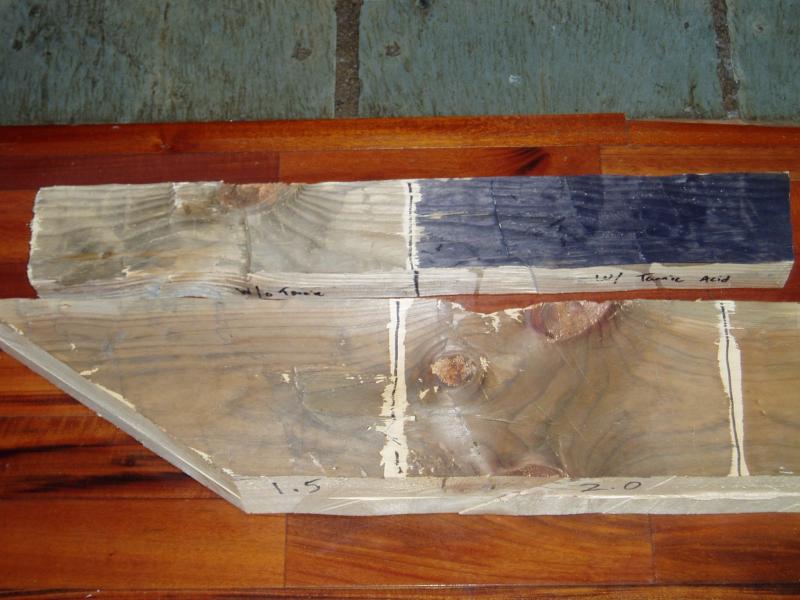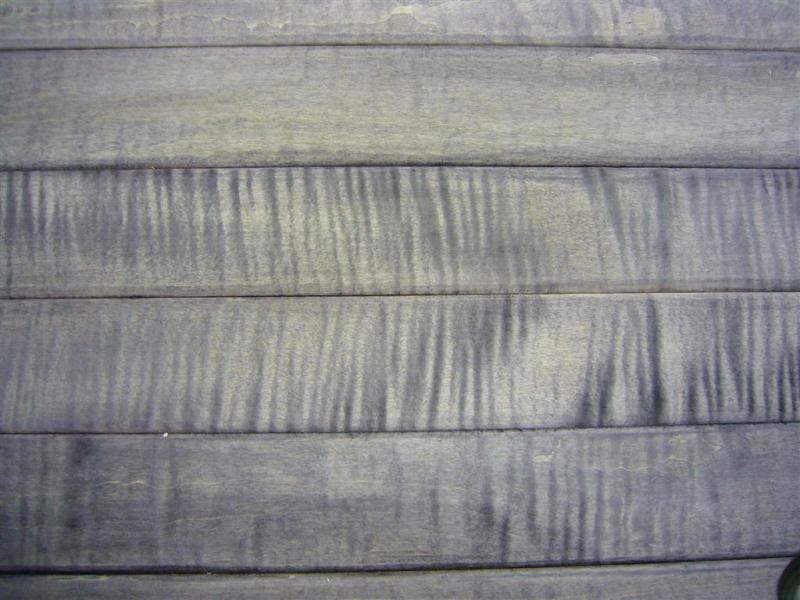Artificially Aging and Weathering Wood
Advice on creating erosion and graying on the surface of boards, without waiting a hundred years. This discussion touches on everything from cow manure to chemistry. February 15, 2009
Question
What is the procedure to age boards to look like they are weathered and have been around a while? I am looking for a grey aged look with some surface checks but still functional.
Forum Responses
(Furniture Making Forum)
From contributor M:
Leave them outside for a while. You might also try using reclaimed material.
From contributor O:
Check out a product called Timeless. Used on rough boards it will give a weathered appearance.
From the original questioner:
Obviously leaving them outside would do the trick. I was looking more at playing Mother Nature and speeding up the process some.
From contributor D:
A buddy of mine has used lime to age white oak timbers.
From contributor G:
You may use a power washer, or a sand blaster, either with some care and a bit of experimentation to selective "weather" wood by eroding the softer summer wood and leaving the harder winter wood. This emulates one aspect of natural weathering. Worm holes require an ice pick and a short temper tantrum. Deep ground in soiling can be done with a rag, a bit of varnish or shellac, and the contents of the domestic vacuum cleaner's dust bag.
From Gene Wengert, forum technical advisor:
I have heard that burying the wood in a pile of manure (animal type unknown) works, as well as putting ammonia on the wood. I have not tried either.
From contributor W:
I heard about the manure pile. A clockmaker my sister-in-law knows answered her question about all the old clocks he had in his shop, "You are over 21, right? Well give me a manure pile and I will give you boards of any age from the 1700's on up." At the time, she was living in a dairy area of Michigan so I suspect cow manure was readily at hand.
From contributor K:
The two part bleach does a lot of the same thing that bleaching by the sun does. Another thing I have seen is using some tile grout rubbed into some of the dings, will give an aged dirty look. You may try asking this in the finishing section also. To get a convincing look will probably take a multiple step process.
From Gene Wengert, forum technical advisor:
All wood species I know of are acidic. Tannic acid is common. However, when adding tannic acid, and then iron sulfate (ferrous sulfate) it is possible to get a dark blue-black color as the acid will form iron tannate. Do a test first.
Bleach will age the surface, but the color will be light. What gives wood its grey color is fungal growth (mold and mildew). Bleach tends to kill mold and mildew so graying will be limited.
From contributor C:
Tannic acid does not produce a blue black color - that is a combination of tannic and ferrous acetate. Ferrous sulfate gives a grey color from light to dark grey depending on the strength. All woods are acetic rather than alkaline, but some have abundance as oak of the tannin principle - meaning it needs no help to form the chemical reaction due to the high amount of tannin content that is naturally present in the wood. Some mahoganies and walnut also posses this to a higher degree. If you want a light grey look - decrease the amount of ferrous sulfate for the mentioned formula above. If you want it darker use more – always make up samples first before applying to the actual project to determine the results. If you or your client are happy with the color you will have to overcoat the processes with a clear to see what the color will truly be - it will change when clear is applied.
As you can see in the image the difference between ferrous sulfate and ferrous acetate and tannin - the acetate is the blue black.

Click here for higher quality, full size image
From contributor D:
Ferrous sulfate does not work without tannic acid. So maple, beech, birch, and ash need tannic acid wash before ferrous sulfate. Here is a maple picture with tannic the FeSo4.

Click here for higher quality, full size image
From Gene Wengert, forum technical advisor:
If you are going to use a two step staining process, why not just use a grey colored penetrating stain? This would be much easier. It seems that a penetrating stain (especially in alcohol with its low surface tension) would color the surface as well as the previous mentioned chemicals would. If you use a penetrating stain, you will get as deep (or even deeper with a surfactant or alcohol) than the previously mentioned stains using tannic acid. You can eliminate the acid issue totally. If you bleach first, you will get some surface degradation as well.
From Gene Wengert, forum technical advisor:
Certainly two coats of alcohol stains are suggested. The amount of fading you indicate is not my experience. After two coats, one year apart, I have seen 9 years with good color. Certainly climate has some effect. Hopefully in nine years the natural aging color is contributing.
Regarding the checking, sometimes (not all species) a shot of dry heat (150 F) on wetted pieces will provide some checking so then re-wet the pieces with water. When the water dries again, there will be some open checks.
From contributor D:
The problem with dyes for aging effects is they tend to be too uniform. They steal all of the contrast between the heartwood and the sap. Yes, dyes are a good method for getting a color but the metallic salt/tannin compounds are a totally different and natural look. The added plus is the metallic compounds that are deposited in the wood do not fade. Dyes on wood floors in front of a window can fade very quickly.
We spend a lot of time re-coloring our old dyed floors that have faded from UV. These are only 7-9 years old and are very washed out. I am not talking about woods that change like walnut. This is a problem with dyed maple, white oak, and ash. Behind glass, the UV strips the color from the dye in a very short period. Luckily this happens slowly enough that the client rarely recognizes the slow subtle change but if you only see the floor once a year the effect is profound every time you visit. I still use dye but have really had fun with the metallic compounds. Plus this is a great story to sell to the client.
From Gene Wengert, forum technical advisor:
I was thinking of outside exposure. For inside, I do think you are correct. (Note that for outside, I do believe that a second application is needed in one year).
From Gene Wengert, forum technical advisor:
I wonder why eye glasses (plastic and glass) today are made with special absorbers for UV-A and UV-B, which ordinary glasses do not (and did not) have. Glass does indeed transmit uv radiation.
From contributor H:
I have been using the cider vinegar/steel wool (ferrous acetate) solution for years, and just started experimenting with ferrous sulfate. The results seem to be about the same on most species. Am I missing something?
From contributor D:
In lower concentrations the colors of ferrous acetate and ferrous sulfate have a different hue. On low tannic woods when you add small amounts of tannic acid wash the color difference is more apparent. For fun do the ferrous sulfate and then wipe with lye water and you get an amber brown. This does not work with the ferrous acetate "rusty nail" color. All these colors are a lot of fun more than always practical and repeatable. It is a good story for the customer that they have trouble sourcing from other companies.
The comments below were added after this Forum discussion was archived as a Knowledge Base article (add your comment).
Comment from contributor J:
I want to say thank you for the formula to manually add age and distress our wood! I used the vinegar/steel wool solution to age/distress a pine wood deacon storage bench and it came almost spot-on to our reclaimed wood dining table. I did a follow-up wash with burnt umber after I aged it with the FS. I could not find anything in the stores that came close to providing this finish. No stain and no paint can duplicate Mother Nature. Now we have to do the same to some new pine snack/nesting tables.

